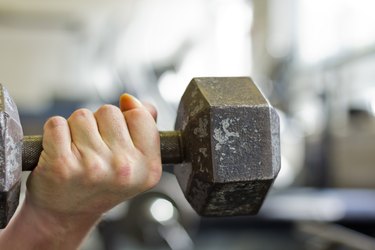
If you want biceps that are strong, shapely and balanced, then including multiple exercises in your overall workout is essential. Two great choices are the dumbbell curl and incline dumbbell curl. Both exercises target the biceps, but there are some key differences in how to perform these movements.
Basic Biceps Anatomy
Video of the Day
You have three flexor muscles located in the front of your arm: the biceps brachii, brachialis and the brachioradialis. All three of these muscles are recruited to some degree when doing the dumbbell curl and incline dumbbell curl.
Video of the Day
When it comes to the incline dumbbell curl, though, it's the biceps brachii that becomes the focus. That's because it is considered the largest and most visible muscle of the biceps, with a short and long head.
The brachialis and the brachioradialis, while still necessary, play a less significant role when doing an incline curl. The brachialis lies deep to the biceps brachii, but it is located closer to the lower arm, whereas, the brachioradialis is a weaker elbow flexor and is more active when the forearm is in a neutral position.
Having a basic understanding of the location and function of your arm muscles enables you to make smart choices when it comes to exercise selection. It also helps you avoid muscular imbalances and promotes a well-conditioned physique. That's why the National Academy of Sports Medicine says that if it's size, strength and definition you're after, you need to perform exercises that target both the upper and lower areas of your arms.
Read more: How to Get Defined Biceps
Dumbbell and Incline Dumbbell Curl
You can effectively train the biceps with both exercises. However, it's important to note a few key differences.
- Standing or seated. You can perform the dumbbell curl standing or seated. If you're seated, the American Council on Exercise recommends sitting with your back against a backrest so that your head, shoulders and butt make contact with the bench. For the incline dumbbell curl, you will sit on an adjustable bench at a 45- to 60-degree level. This move is not performed standing.
- Amount of weight to use. Another key difference is in the amount of resistance. In general, you should be able to use a higher weight with the traditional dumbbell curl because you either sit upright or stand. You also place less tension on the biceps. To do the incline dumbbell curl correctly, choose a lighter weight to keep your form tight, which ensures that you're not letting your shoulders take over.
- Area of the biceps targeted. Since both of the curl exercises target your biceps, it may seem like they are equal in function. However, due to the position of your body, the incline dumbbell curl targets the long head of the biceps brachii muscle more than a traditional dumbbell curl. And placing more tension on this part of your arm is what builds and sculpts your biceps peak.
- Stabilizer muscles recruited. Both moves require stabilizers to help out, but the dumbbell curl recruits more muscles than the incline dumbbell curl. The anterior deltoid, upper and middle trapezius, levator scapulae and wrist flexors all act as stabilizers during the traditional dumbbell curl. The incline curl, on the other hand, only relies on the anterior deltoids and wrist flexors as stabilizers.
Read more: 10-Minute Arm-Sculpting Workout
Resistance Training Tips
The U.S. Department of Health and Human Services physical activity guidelines recommend that adults participate in muscle-strengthening activities of moderate to greater intensity involving all major muscle groups at least two or more days each week.
When performing resistance training workouts, the National Strength and Conditioning Association recommends at least one day, but no more than three, between workouts that stress the same muscle group or groups.
If you're using a full-body training model, this means training two to three days a week with at least one day off between sessions. This ensures that you will hit all of the major muscle groups while still allowing enough time to rest your muscles between workouts.
With that in mind, you can include the traditional dumbbell curl exercise on training day 2 and the incline dumbbell exercise on training day 2. If you do an additional day of weight training, choose between the two curl exercises or alternate with a different arm exercise such as cable curls or biceps machine curls.
In addition to biceps exercises, be sure to include compound moves such as squats, chest press, shoulder press, lunges and bent-over rows. And don't forget to train your core with exercises like planks, supermans and bridges.
- ExRx.net: "Dumbbell Incline Curls"
- ExRx.net: "Dumbbelll Curls"
- National Strength and Conditioning Association: "Determination of Resistance Training Frequency"
- American Council on Exercise: "Arm Exercises"
- National Academy of Sports Medicine: "9 Arm Exercises for Definition and Strength"
- U.S. Department of Health and Human Services: "Physical Activity Guidelines for Americans, 2nd Edition"
- University of Washington, Department of Radiology: "Biceps Brachii"
- University of Washington, Department of Radiology: "Brachiallis"
- University of Washington, Department of Radiology: "Brachioradialis"